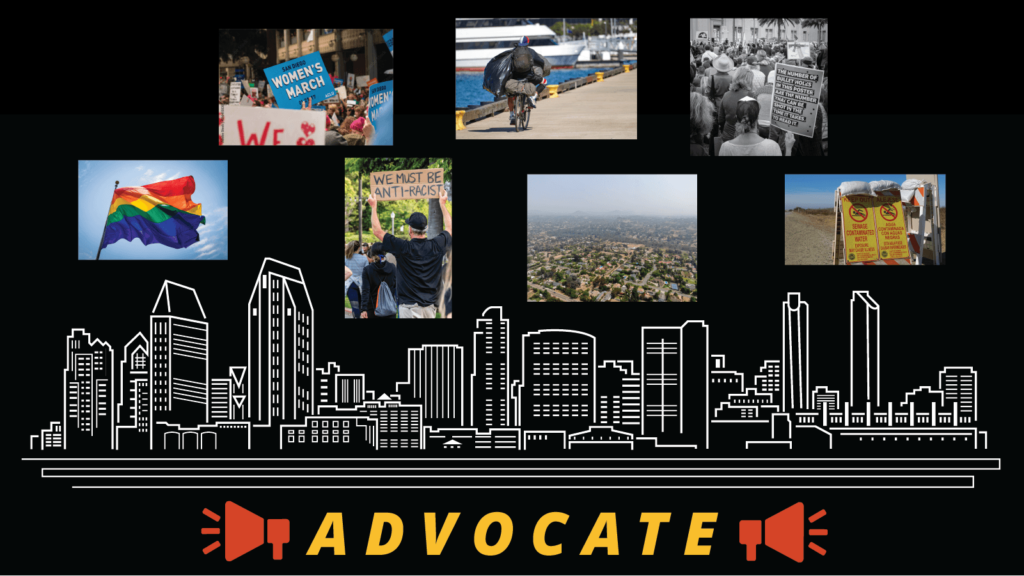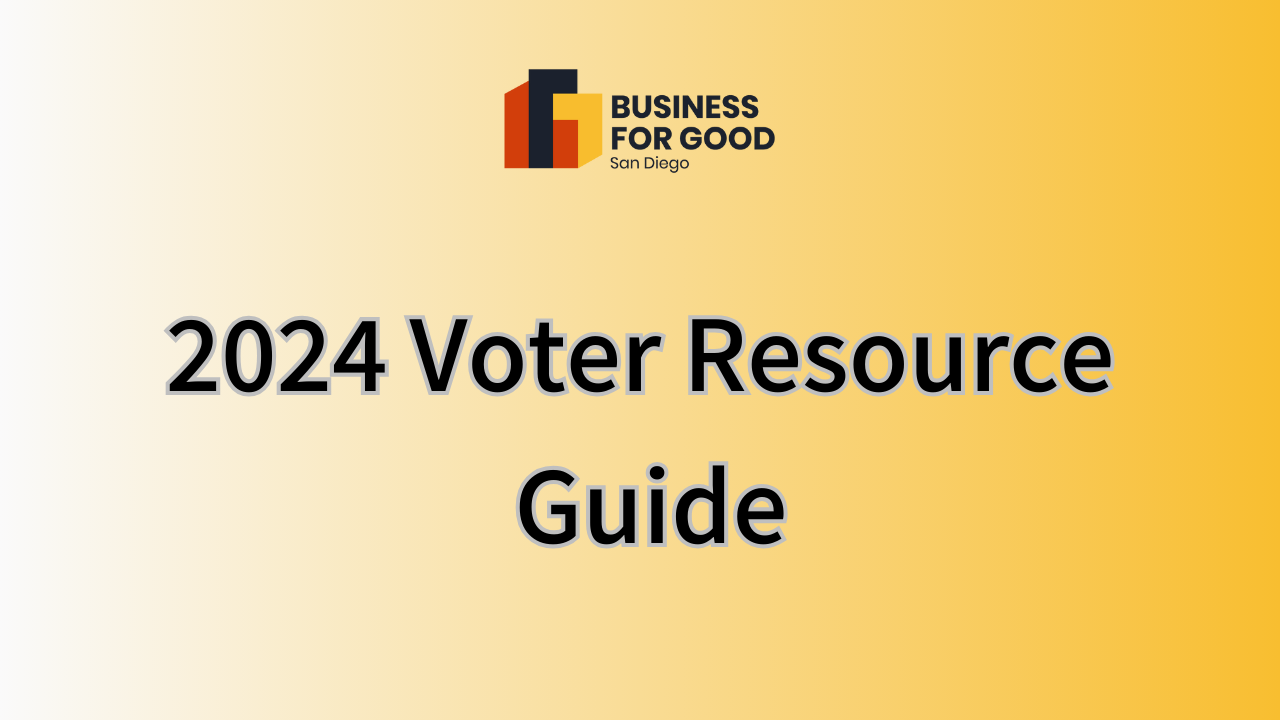How to Be an Advocate for Business For Good—Or Anything Else

The high cost of living. Widespread homelessness. Increased traffic. The fight for affordable, clean energy.
Whatever our differences may be, all San Diegans can agree that a thriving existence here is more challenging than ever.
Every day, San Diego business owners ask us what they can do to help change this. They’re proud of where they live, the businesses they’ve built, and the communities they serve. They want America’s Finest City to feel like it’s exactly that, for all who live here.
Advocacy is the answer. Time and again, the power of the people’s will is the proven path to invoking change.
Business For Good wants to prepare all our members with the skills and knowledge they need to be confident advocates for local policy change.
We founded BFG because we wanted to make a difference. And this is how you can do it.
How Change Happens—The Theory of Change
Advocacy varies in size and scope. But the most successful advocacy organizations follow an actionable blueprint to make meaningful change happen.
Mikey Knab, BFG co-founder and BFG Board of Directors Chair, is a seasoned local and national advocate who swears by the Theory of Change used by Climate Action Campaign (CAC).
“Decades of activism on behalf of [CAC Executive Director] Nicole Capretz and her talented coalition partners helped inform this theory of change,” Mikey said. “This theory is especially well-situated for local change here in San Diego.”
The Theory of Change has five steps. Advocacy that works incorporates each of these steps carefully.
Step 1: Community Will
Community will is how willing people are to support a specific issue. Do they care about it? And if they do, do they care enough?
You need community will to get traction for any advocacy issue. It’s the only thing that will move your cause into action. If people don’t care, then there won’t be any public support for your cause.
So, how do you measure what a broad group of people thinks about something?
- Polls
- Watching headlines to gauge the zeitgeist of public opinion
- Voting results of previous elections
After you’ve done the research and decided there is community will for your cause, you need to move it into action to create change.
There are two ways to do that—either by introducing legislation or putting it on a ballot for the general vote.
“Most issues are not run through a general ballot,” Mikey said. “We have a representative democracy in the US. That means we rely on our elected representatives to vote in favor of community will.”
Business For Good’s sweet spot is persuading our elected representatives that the community will exists to support the causes we champion.
That’s why the policy action BFG works on is mostly centered around municipal legislative action, not creating ballot initiatives.
“Every elected official loves local business owners,” Mikey said. “We are the driving force of the local economy, our community trusts us, and we’re well respected. That’s why Business For Good is a widely revered policy influencer in San Diego.”
Step 2: Coalitions
Once your issue has community will, it is vital you seek out coalitions that align with it.
“Coalitions are key because they amplify the importance of your issue to elected officials,” Mikey said. “When a group of community organizations all show up in support of the same cause and speak to their unique angle on the topic, it really rounds out for elected officials why this issue is important enough to push forward.”
There are also several big internal benefits of coalitions for an organization:
- Sharing resources, accountability, and workload—Very important when your organization has limited capacity.
- Creating lasting relationships with values-aligned organizations—Coalitions are reciprocal and authentic. You can call on your coalition partners when you need legislative help, and vice versa. Most effective coalitions are not transactional. They are aligned on a deeper level, recognizing that all our causes are interconnected. Injustice anywhere is injustice everywhere.
- Temporary or long-term in nature—Successful coalitions know exactly what issue they are working on and they remain fixed on it. All coalition partners must be transparent and forthright about the immediate goal of the coalition. Some coalitions are temporary, some are long-term. It depends on what you’re trying to achieve.
Step 3: Political pressure
No amount of political pressure matters without community will.
That’s why it is vital to thoroughly complete the first two steps in the Theory of Change before moving on to political pressure.
Political pressure means taking community will and applying pressure to anyone with decision-making power through an inside/outside game:
- The inside game is meeting directly with elected officials to deliver your message and convince them to do what you want. You can do this either as a lobbyist (paid by an organization to meet with elected officials) or as an advocate (unpaid).
- The outside game is posting your message in the public forum, where you know your targeted elected official(s) will see it. For example, if you know your elected official reads the Union-Tribune every Sunday, you may work to place an article there so they’ll be sure to read it.
But how do you know which elected leaders to target? By using a brilliant analytical tool called power mapping.
Power analysis, or power mapping, was developed by Anthony Thigpenn, a leading expert and facilitator of grassroots programs, for social justice organizations to use in building strategies to win campaigns.
Power mapping is a way to organize elected officials by level of support for your cause and influence so that you can decide who will be most effective to apply pressure on for your cause.
You can also make a power map for an elected leader. Who are the people in that person’s environment and sphere of influence? Who and what do they care about? Then you can tap into those arenas to influence that leader even more.
There are two types of political pressure:
- Positive political pressure: “If you help us, we will endorse you and then you’ll get more voters in your favor.”
- Negative political pressure: “If you’re not with us, you’re against us. We don’t want to say bad things about you and shame you, but if that’s the only way, we will.”
Business For Good prefers to remain high-road. “We use positive political pressure whenever possible,” Mikey said. “But if an issue really demands it, we will consider an oppositional strategy.”
Step 4: Watchdogging
Watchdogging is one of the most overlooked steps in advocacy.
Even professional advocates tend to either skip this step or blow right past it. But without proper watchdogging, your entire advocacy effort is at risk of becoming a loss.
“At this stage, the advocates’ job is not done,” Mikey said. “We have to watchdog. We need to hold elected leaders accountable who helped pass our cause. You said you were going to take specific actions to put our issue into effect. Did you actually do that? What steps are you taking to enforce it?”
Effective watchdogging is tiring but necessary. It means you must keep up with every promise the elected official made, from the start of the new legislation to present day—and ensure they’re doing what they said they’d do.
“Pay it back, and call it out,” Mikey said. “We have to get the backs of the elected officials who responded to us by uplifting their honesty and the consistency of their actions with their campaign promises. They deserve our support through their election cycles.”
Step 5: Replicate
The final step in the Theory of Change is another one that even seasoned advocates tend to gloss over.
Sometimes, legislation that you pushed for is passed, but doesn’t seem to be working. You need to ask why. It is usually because the policy is not meeting the moment.
For example, say a law is passed that allows for up to 1,500 cubic yards of composting for local restaurants. But not many restaurants are engaging in that.
When you take a closer look, you realize that 1,500 cubic yards only equals about 40 restaurants—and there are tons more in your region. You recognize that the original policy ask you pushed for was flawed. Now it needs to be replicated.
You’ll have to gather the same coalition to make the change. In this example, you’d need to ask to increase the composting cap to make the legislation effective.
“Don’t be lazy with replication,” Mikey said. “Go through the whole piece of legislation and exercise again. Because if you missed one thing, you probably missed other things too.”
Replication gives an opportunity to strengthen the connective tissue between yourself and the community, coalition partners, and electives who are carrying water for you.
Other advocacy tactics that work
Outside the Theory of Change, Mikey offers advocates a list of other helpful tactics you can use to strategically advance your cause.
- Name the opposition: If you have clear opposition that is acting in bad faith, call them out and name them. Connect them to the elected leaders either acting on their behalf or upholding a harmful status quo. But never embellish or lie. “Authenticity is our weapon at BFG,” Mikey said. “If something is worth working on, the truth is enough.”
- Personal stories: Using personal stories to illustrate the impact of your cause is the single most effective tool for advocacy. It connects people to the human piece at the heart of the issue. “Data is important, but people can still use factual data to support a particular angle that doesn’t necessarily show the whole picture,” Mikey said. “When you’re trying to rally community will, stories matter more than anything else.”
- Counter-messaging: Name your opposition’s incentive. Figure out why they oppose your cause. Who, or what groups, does this opposition serve? Pretend you’re their PR person. Write out all their messaging points then tear them apart to identify all the externalities they’re not sharing.
- Be relentless: It’s true—the squeaky wheel gets the grease. “You won’t get exactly what you want for being annoying, but elected officials cannot ignore you forever,” Mikey said. “They do not want to be called out for the same question until the end of time. Eventually, they will have to address you and your ask.”
- Relationship-building: Always strive to build reciprocal, honest relationships with the community and elected officials—even if they are on the other side. Respect the office they hold (even if you don’t respect their beliefs), otherwise, it is anti-democracy and BFG is not that. “In the end, change is all about power,” Mikey said. “In service to the movement, share your access, power, and resources with coalition partners and others. Be generous. That is the difference between being transactional and collaborative. And only being collaborative brings about real change.”
- Join a movement—don’t try to reinvent one: Step up, or step back. Find an advocacy group around your cause and lend yourself to them. Add capacity and value. Don’t try to recreate the group’s mission and goals through your own personal lens. That slows everything down and can create fracturing within the group.
“Not everything needs to be created from whole cloth,” Mikey said. “All of our different issues are interconnected, and all feed into the root cause of the problem we’ve identified—inequality and injustice. Leaders don’t just lead from the front. They can and should lead from behind, or from the side. We should always uplift the people who didn’t know they could make a difference.”
To get started with local advocacy, become a Business For Good member or join us for our (Doing) Business For Good Summit on November 9th where we will build a campaign strategy plan LIVE!
